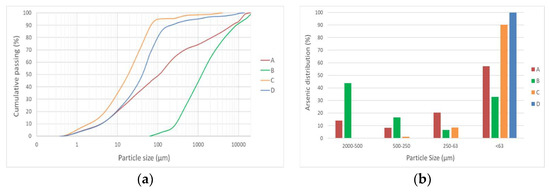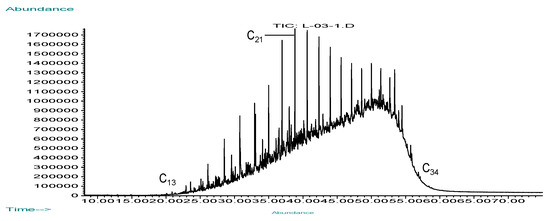Abstract
An environmental forensic study was developed in a former industrial area in southern Spain. Previous information about the site revealed arsenic and hydrocarbons affection exceeding soil screening levels. A full characterisation of arsenic affection was thus performed. In this regard, the bioavailable fractions, arsenic speciation and grain-size distribution were determined. Two different polluted types of soils/fillers were identified. The first one is affected by non-bioavailability As(V) concentrations on the finer fraction, and the other one is affected by As(III) and As(V) with higher bioavailability than the other case, affecting all grain-size fractions homogeneously. Notably the textures are very heterogeneous within the site. On the other hand, hydrocarbons affection was also studied. Cuantitative and cualitative organic analyses revealed the presence of organic products with differing degree of degradation (naphthas). An additional microbiological study revealed regular microbial counts for a non-fertilized soil, and an edaphological characterization showed alkaline soils with low levels of nutrients and natural organic matter. The information gathered was used to evaluate remediation feasibility. Soil washing was selected as an interesting possibility for arsenic removal, although grain-size distribution must be studied carefully because of high variability. As regards as organics, bioremediation is a valuable option due to the suitable microbiology and the type of hydrocarbons found, together with the usual low costs of techniques such as landfarming or biopiles.
1. Introduction
In Europe in the latest decades, the recent closure of industrial and mining facilities has revealed the existence of large volumes of contaminated soils, especially in the context of urban or peri-urban areas. These sites are known as brownfields [1], and they are particularly abundant wherever heavy industry and mining had a decisive presence in the past, with the particularity that they usually present organic and inorganic contaminants together (concurrent contamination).
The contamination by hydrocarbons can be generated from various sources, including the production, transport, storage and use of petroleum products. However, the main toxic families of hydrocarbons (BTEX and PAHs) can be removed by means of volatilization, chemical oxidation, adsorption, or the most successful, microbial transformation and degradation, known as bioremediation.
In addition, potentially toxic elements (PTEs) are prolific in brownfields too. Concretely, arsenic is highly toxic and carcinogenic, which compromise ecosystems quality and human health. The remediation of arsenic-contaminated soils require physic-chemical methods such as solidification/stabilization, soil washing, electrokinetics, nanoremediation or biological such as phytoremediation. One of the most efficient technique of those mentioned is soil washing, consisting in the removal of contaminants by concentrating them into a minor volume by means of physical and/or chemical procedures [2].
In order to carry out an efficient remediation for both organics and PTEs, an exhaustive characterization of soil properties is necessary [3]. In this study, a full characterization of arsenic and hydrocarbons affection in an industrial site was thus performed, and information gathered was used to evaluate remediation feasibility.
2. Materials and Methods
2.1. Study Area
The study site was one of the main fertilizer plants in southern Spain for almost forty years until its closure in 1997. Following the dismantling works in 2001, characterization studies revealed arsenic and hydrocarbons affection exceeding soil screening levels. In order to determine the current state of soils, six samples of about 5 kg were taken from the site. Two samples were analyzed to determine hydrocarbons affection and the other four samples to assess arsenic affection.
2.2. Arsenic Study
A full characterization of arsenic affection was performed. Collected samples (A, B, C, D) were air dried and sieved (<2 mm) prior to analysis—except for the grain-size study.
Total As concentration in the soil samples were determined by inductively coupled plasma mass spectrometry (ICP-MS). Availability of As in soil samples was determine by the sequential extraction procedure proposed by Tessier et al. (1979). The relatively availability is: (EX) extractable > carbonate-bound (CB) > Fe/Mn oxides-bound (OX) > organic matter-bound (OM) > residual (RS). Arsenic speciation was determined by means of HPLC coupled to ICP-MS. A representative sample of the material was wet-sieved into 12 particle-size fractions between 63 and 20,000 microns. To complete the grain size characterisation, the silt-clay fraction (<63 µm) was study using a Laser Diffraction Particle Analyzer (Beckman Coulter Inc.). In order to determine arsenic distribution, four fractions were established in function of granulometric curve to analyzed total As concentration: <63, 63–250, 250–500 and 500–2000.
2.3. Hydrocarbons Analyses
Collected soil samples (E, F) were air-dried and sieved (<2 mm) prior to hydrocarbons affection analyses—except to microbiological study.
For qualitative determination, sub-samples were extracted using a Soxhlet apparatus and the extracts purified with liquid chromatography (EPA Method 3540C). The purified extracts were examined using GC. The chromatograph was linked to a mass detector for identification of compounds in selective ion mode (SIM) using library mass spectra (EPA Method 8270C).
Soil pH was measured in a suspension of soil and water (1:2.5) and electrical conductivity was measured in the same extract (diluted 1:5). The Kjeldahl method was used for determine nitrogen content, the Olsen method for phosphorus content, the Bernard calcimeter for carbonate content and organic matter was determined by the Walkley-Black. Available nutrients (Ca, K, Mg, Na) were analyzed by atomic absorption spectrometer. Bouyoucos densimetry was used to determine texture.
Microbial populations were monitored using conventional plate counting with a rich complex medium designed for growing most cultivable organotrophic bacteria (3% tryptic soy broth, 0.05% yeast extract, and 1% agar; Merck).
3. Results
3.1. Arsenic Affection
Arsenic concentration in all samples are similar and exceed soil screening levels (40 mg/kg). From grain-size viewpoint, samples are diverse, from more percentage of sand to clay: B > A > C > D. However, arsenic is enrich in the clay fraction—except sample B which arsenic distribution is uniform (Figure 1).

Figure 1.
(a) Particle-size distribution of samples obtained by compositing wet-sieving and laser dispersion data; (b) Arsenic distribution along granulometric fractions in percentage.
Respect arsenic bioavailability (EX and CB fractions) (Table 1), samples A and B presented medium values, and sample C high. However, sample D revealed an extremely low bioavailability. In addition, sample D is the only one without As(III), so the pollution source in this sample must be different than the others.

Table 1.
Chemical results from arsenic affection analysis.
On the whole, soil-washing seemed to be appropriate for remediation given that the majority of the contaminants could be easily screened to be concentrated in a fine fraction with low costs. However, the high grain-size variability would require detailed soil texture analyses and probably different approaches for the two types of As-pollution found.
3.2. Hydrocarbons Affection
The chromatograms obtained corresponds with an oil-related mixture (naphta) partially degraded, without volatiles and with high presence of alkanes (maximum abundance in 21), aromatic compounds and sulfur heteroatomics. C18/Pr index is slightly lower than 1 (0.91), which suggest a degradation process neither long nor intense (Figure 2, sample F). Nevertheless sample E although revealed the same product (naphta), showed a C18/Pr index considerably lower (0.54), which may be a sign of higher degradation.

Figure 2.
Chromatogram of sample F.
Soils samples are very alkaline (pH around 8.7), poor in organic matter, nitrogen and phosphorus. However, relation C:N (>13.3) and carbonate content is normal. Higher K and Ca concentrations can impoverish soils. Therefore, in case of any biological remediation, fertilizers must be added.
Microbiology study releases a suitable number of bacteries (105 UFC/g soil), which probably are adapted to contaminants. The bacterial diversity found facilitates a biological remediation.
As a conclusion, the hydrocarbon affection is being decreased by natural attenuation, and thus a bioremediation (landfarming or biopiles) can be cost-effective and accelerate the degradation through fertilizers addition, watering and mechanical aeration.
4. Conclusions
In general, contaminants concentration detected are lower than presents in prior studies thereby suggesting a natural attenuation process. In case of arsenic affection, remediation feasibility via soil washing was demonstrated. We suggest wet-sieving in order to separate the clay fraction which contained the majority of arsenic. However, a detailed study should be carried out to identify different texture soils and arsenic distribution.
Hydrocarbon affection is due to naphta compounds with diverse degrees of degradation. Natural attenuation is taking place, but a bioremediation could accelerate the process. Edaphological and microbiology studies suggest the application of landfaming or biopiles.
Author Contributions
J.L.R.G., A.I.P. and E.R.-V. conceived and designed the experiments; C.B., N.M. and N.G. performed the experiments; D.B. and J.L.R.G. interpreted the results and wrote the paper.
Acknowledgments
Diego Baragaño and Carlos Boente obtained a grant from the “Formación del Profesorado Universitario” program, financed by the “Ministerio de Educación, Cultura y Deporte de España”.
Conflicts of Interest
The authors declare no conflict of interest.
References
- Gallego, J.R.; Rodríguez-Valdés, E.; Esquinas, N.; Fernández-Braña, A.; Afif, E. Insight into a 20-ha multi-contaminated brownfield megasite: An environmental forensics approach. Sci. Total Environ. 2016, 563, 683–692. [Google Scholar] [CrossRef]
- Sierra, C.; Menéndez-Aguado, J.; Afif, E.; Carrero, M.; Gallego, J.R. Feasibility study on the use of soil washing to remediate the As-Hg contamination at an ancient mining and metallurgy area. J. Hazard. Mater. 2011, 196, 93–100. [Google Scholar] [CrossRef] [PubMed]
- Boente, C.; Sierra, C.; Rodríguez-Valdés, E.; Menéndez-Aguado, J.M.; Gallego, J.R. Soil washing optimization by means of attributive analysis: Case study for the removal of potentially toxic elements from soil contaminated with pyrite ash. J. Clean. Prod. 2017, 142 Pt 4, 2693–2699. [Google Scholar] [CrossRef]
Publisher’s Note: MDPI stays neutral with regard to jurisdictional claims in published maps and institutional affiliations. |
© 2018 by the authors. Licensee MDPI, Basel, Switzerland. This article is an open access article distributed under the terms and conditions of the Creative Commons Attribution (CC BY) license (https://creativecommons.org/licenses/by/4.0/).